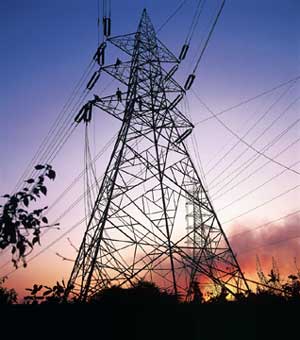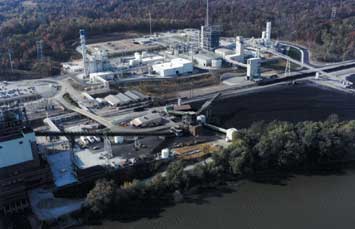Xcel screws up service again
February 9th, 2007
… there they go again, sending out their “Request for Exemption from Certain Certificate of Need Application Content Requirements,” and of course they didn’t serve one on moi. They didn’t serve anyone from Prairie Island either.

Here’s the Request they don’t want me to have:
I think it’s about time to have this docket thrown out for process errors. I’ve asked for the Comment period to be set back 10 days, because by the time they get around to getting me served… and I note they didn’t serve Prairie Island either. Maybe I can bring my grrrrrrls and Lori Michel can bring her SIX chihuahuas…
RES doesn’t require transmission!
February 8th, 2007
Everybody’s cheering the passage of SF 004 – the Renewable Energy Standard. But why does the Senate open the door to more perks for market transactions — bulk power transmission? That’s not a good thing… we don’t need transmission. READ THE WIND INTEGRATION STUDY – HERE!!
Here’s the problematic part of SF004 (CLICK HERE FOR LINK):
Sec. 2. TRANSMISSION FOR RENEWABLE ENERGY STANDARD.
Minnesota electric utilities, as defined by Minnesota Statutes, section 216B.1691,
Subdivision 1, paragraph (b), must study and develop plans for the transmission network enhancements necessary to support the renewable energy standards and milestones established in Minnesota Statutes, section 216B.1691, subdivision 2a. The study process must be designed to identify and optimize delivery of that renewable energy to Minnesota retail customers while maintaining system reliability.
As part of the planning process, Minnesota electric utilities shall incorporate and build upon the analyses that have previously been done or that are in progress, including, but not limited to, the 2006 Minnesota Wind Integration Study and ongoing work to address geographically dispersed development patterns. The Minnesota electric utilities shall collaborate with the Midwest Independent System Operator to optimize and integrate to the extent possible Minnesota’s transmission plans with other regional transmission considerations.
As part of the planning process, utilities shall convene and regularly consult with a group of stakeholders with experience and expertise in transmission system engineering and renewable generation technology to review the study’s proposed methods and assumptions, preliminary results, and ongoing efforts.
Utilities shall submit a report to the Minnesota Public Utilities Commission by November 1, 2007, describing the activities undertaken pursuant to this section. The report shall include:
(1) a description of the analyses that have been undertaken and the results, including the critical issues that need to be addressed in order to develop the transmission needed to meet the standards and milestones of Minnesota Statutes, section 216B.1691, subdivision 2a;
(2) a comprehensive conceptual plan to guide ongoing planning efforts to develop the transmission necessary to support those standards and milestones;
(3) specific transmission line proposals necessary to meet those intermediate standards and milestones;
(4) a description of how the results of these studies have been reflected in the biennial transmission reports filed under Minnesota Statutes, section 216B.2425; and
(5) a five-year action plan that identifies with specificity the actions necessary to implement the specific proposals and to refine and further develop the transmission plans needed to support those standards and milestones, including initiating any certificate of need or other regulatory proceeding necessary to implement the specific proposals identified above.
Why is this in here? Wasn’t the 2005 Transmission Omnibus Bill from Hell enough? Why aren’t we repealing the noxious parts of that bill?
HUH?? Oh, great idea…
Environmental Groups clash over support for clean coal plants
February 8th, 2007
Here’s a revised version of the other Inside Washington article:
ENVIRONMENTAL GROUPS CLASH OVER SUPPORT FOR CLEAN COAL PLANTS
Date: February 9, 2007 –Environmental groups are split over their stance on power plants that use advanced coal technologies with local environmental groups accusing national groups of supporting integrated gasification combined cycle (IGCC) technology because they recently received grant money to do so. However, the national groups vigorously deny those accusations.
National groups including the Clean Air Task Force (CATF) and the Natural Resources Defense Council (NRDC) last year received first-time grant money from the Chicago-based Joyce Foundation to support clean coal technology with carbon sequestration. The grants marked a shift from traditional money available to environmental groups, which is generally used for litigation and education efforts. That is setting the stage for a potential ideological divide among traditionally aligned environmental organizations, with local groups that oppose all new coal-fired generation levying accusations at the groups that received the grant money.
But CATF and NRDC strongly defend their positions and say they have not changed since winning the Joyce Foundation grants. CATF supports specific IGCC projects in the Midwest, while NRDC does not address individual plants. It opposes conventional coal plants and promotes advanced coal technology as long as it sequesters carbon dioxide (CO2).
IGCC gasifies the coal before burning it, making it easier to capture conventional pollutants and allowing for the potential CO2 sequestration. But because no full-scale IGCC plants have come online, there is much debate over the efficiency and affordability of the power generated from the plants, and whether sequestration is ultimately possible (see related story).
Smaller, local activist organizations and some sources at Greenpeace — all groups that do not receive the Joyce Foundation funding — complain that the national groups are motivated in part by the grant money.
“They are literally getting paid to promote coal gasification,†charges a member of a local environmental group.
A Joyce Foundation source argues that NRDC and CATF’s positions have not changed due to the grants. The foundation began a $7 million initiative in 2005 to push industry to embrace IGCC technology and awarded $3 million in 2006 to environmental groups to specifically promote clean coal technologies. CATF received $787,500 and NRDC got $437,500.
CATF admits carbon capture and storage still has a long way to go to fill in the technology gaps. “It will take eight to 10 years of serious testing on a large scale, but we won’t get there unless we have the CO2 in order to test the formation,†the CATF source says. The goal is to be able to do large-scale CO2 sequestration — on the scale of up to 100 percent of the CO2 from 50 IGCC plants for 50 years — by 2030. The source says the Illinois valley has the potential for that kind of storage.
CATF is supporting proposals by the ERORA Group to build a 770-megawatt (mw) IGCC facility in Illinois.
In an e-mail to an Illinois environmental activist, CATF touts benefits of the proposed IGCC plant there, saying the plant’s design includes “the technology needed to capture CO2. As carbon capture ready plants go, this one is about as ready as you get. To get full CO2 capture, ‘all’ that is needed is a water shift reaction and some turbine modifications, plus equipment to compress the CO2. I use the term ‘all’ with some hesitation because these items are not cheap,†the CATF e-mail says.
Separately, NRDC is not supporting this or any individual plant. NRDC says it pushes for IGCC because of the limited leverage groups have to address proposed coal-fired power plants under the Clean Air Act and that IGCC is a critical component of their overall legal strategy because it is currently the cleanest way to burn coal to produce electricity.
As part of that strategy, NRDC sued EPA last year over a determination that regulators did not need to consider IGCC when conducting best available technology (BACT) reviews for new coal plants. NRDC and EPA recently reached a proposed settlement that would allow — but not require — regulators to consider IGCC as BACT.
The NRDC source notes, “We’re not supporting any particular plant. We’re saying . . . [industry] should use the best available technology.†Additionally, the source notes the group supports a diversified energy mix. “We have never wavered in our support for renewable energy. But at the end of the day, the Clean Air Act offers very little authority to block a plant by arguing a no-build option.â€
IGCC supporters also believe that the technology will also eventually allow for the capture and sequestration of CO2, which they consider a necessary step to tackle global warming.
But Greenpeace and the local groups point out that geologic storage of CO2 is a complete unknown. NRDC and CATF “say this is good because we can capture carbon, but the analysis of the cost of sequestration is such that nobody would do it,†says a source with Valley Watch, a Midwest environmental group.
Instead, these groups are urging that new generation be shifted away from coal and that resources be used to develop wind and solar generation as well as to modernize the electricity grid.
But an industry source says the no-coal position is not viable or realistic because coal is safe and abundant. However, the source is also skeptical about IGCC’s viability.
Source: Inside EPA via InsideEPA.com
Date: February 9, 2007
Issue: Vol. 28, No. 6
© Inside Washington Publishers
Enviro position on IGCC follows the $$$$
February 8th, 2007
The Clean Air Report has a piece on dollars to “environmental” groups for support and promotion of IGCC — scroll down! The purpose and impact of all this money being handed out for promotion of IGCC has been apparent in Excelsior’s inclusions and citations of Clean Air Task Force and Natural Resources Defense Council support of IGCC. David Hawkins, in a comment on this blog, claims that promotion of IGCC is not in NRDC’s mission — OK fine, so stop taking money to do just that, and stop promoting IGCC!!! But it’s not just CATF and NRDC, and the light shining on this enviro “promotion for dollars” is NOT going away, particularly where those promoting it are not paying attention to the IGCC COST record of the Mesaba case, the emissions profile of Mesaba, the DOE – Supplement to DEIS on Sequestration in the PA case… and the $2,155,680,783 or $3,593/kW cost of Mesaba… but hey, who needs the facts…
From Joyce Foundation press release:
Announced August 2006
Clean Air Task Force, Inc.
Boston, MA $787,500
To promote Integrated Gasification Combined Cycle in the upper Midwest. (21 mos.)Clean Wisconsin, Inc.
Madison, WI $500,000
For a coordinated administrative intervention and public information campaign aimed at promoting coal gasification with sequestration as an alternative to conventional coal plants proposed for Wisconsin. The Wisconsin Citizens Utility Board would also be a partner in the intervention and campaign. (1 yr.)Energy Foundation
San Francisco, CA $100,000
To support smaller-scale efforts to contest the licensing of conventional coal plants in the Midwest. (1 yr.)Great Plains Institute for Sustainable Development
Minneapolis, MN $437,500
To support the efforts of its Coal Gasification Working Group. (21 mos.)Michigan Environmental Council
Lansing, MI $87,500
To persuade regulators, utilities, and power plant developers in Michigan that any new coal plants should be able to use the latest technologies for capturing and storing carbon emissions. (21 mos.)National Wildlife Federation
Reston, VA $122,700
To build support in Indiana and Michigan for coal gasification as an alternative to conventional coal-burning power plants. National Wildlife Federation affiliates Indiana Wildlife Federation and Michigan United Conservation Clubs would be partners in this effort. (21 mos.)Natural Resources Defense Council, Inc.
New York, NY $437,500
For its efforts to oppose the construction of new conventional coal plants and promote alternative plants using coal gasification with carbon sequestration. (21 mos.)Ohio Environmental Council
Columbus, OH $113,750
To support its ongoing efforts to promote IGCC in Ohio and to oppose the permitting of a conventional coal plant proposed by AMP-Ohio, a municipal utility consortium. (21 mos.)Resources for the Future, Inc.
Washington, DC $75,000
To conduct a quantitative assessment of the risks to shareholders and electric utility ratepayers of investing in various coal combustion technologies. (1 yr.)Rockefeller Family Fund
New York, NY $50,000
To support ongoing coal advocacy activities of the Renewable Energy Alignment Mapping Project. (1 yr.)University of Wisconsin-Madison Center on Wisconsin Strategy
Madison, WI $175,000
To build support among labor leaders in Wisconsin and other Midwest states for coal gasification as an alternative to conventional coal power plants. (21 mos.)Announced May 2006
Izaak Walton League of America, Inc.
St. Paul, MN $300,000
To support intervention in the licensing hearings for the Big Stone II power plant in South Dakota and Minnesota. (1 yr.)
==========================================================
HERE’S YESTERDAY’S CLEAN AIR REPORT ARTICLE:
February 8, 2007
ENVIRONMENTALISTS’ POSITION ON CLEAN COAL SPLITS ALONG FUNDING LINES
SECTION: Vol. 18 No. 3
LENGTH: 1418 words
Environmental groups that are supporting clean coal technology for new power plants are in many cases receiving grant money specifically to support clean coal, while other groups that are not receiving the funding are opposing any new coal generation in favor of renewable energy. This split among green groups comes ahead of an expected mandatory domestic policy to address climate change.
National environmental organizations including the Natural Resources Defense Council (NRDC) and the Clean Air Task Force (CATF) are actively supporting proposals to build integrated gasification combined cycle (IGCC)
coal-fired power plants in the Midwest after winning grant money from the Chicago-based Joyce Foundation last year to support these types of projects.The Joyce Foundation’s clean-coal grants marked a shift from traditional grants to environmental groups, which are typically used for litigation and education efforts. The new types of grants are marking the beginnings of an ideological divide among traditionally aligned environmental organizations that are now taking opposing positions during proceedings to build several IGCC plants.
IGCC gasifies the coal before burning it, making it easier to capture conventional pollutants and allowing for the potential sequestration of carbon dioxide (CO2). But because no full-scale IGCC plants have come online, there is much debate over the efficiency and affordability of the power generated from the plants, and whether sequestration is ultimately possible.
The support for IGCC by NRDC and CATF is prompting accusations from smaller, local activist organizations and some sources at Greenpeace — groups that do not receive the funding — who complain the environmentalists supporting IGCC are motivated in part by the grant money. These groups believe that IGCC facilities will never sequester CO2 due to costs.
“They are literally getting paid to promote coal gasification,” says a member of a local environmental group opposing a proposed IGCC plant in Minnesota.
However, NRDC, CATF and the Joyce Foundation — which last year offeredgrants to promote advanced coal technologies such as IGCC — vigorously defend their positions.
A Joyce Foundation source notes that these groups recognize that coal will be a significant part of the nation’s energy future and that it is in their best interest to ensure the plants are the cleanest possible.
“Their view is changing independently of our funding,” says a Joyce Foundation source. The group began a $7 million initiative in 2005 to push industry to embrace IGCC technology and awarded $3 million in 2006 specifically to environmental groups to promote clean coal technologies.CATF received $787,500 and NRDC got $437,500.
“Over the last 46 months there has been a growing recognition that coal will continue to be a part of the energy mix. A novel thing about the foundation is our recognition that we have to learn to live with coal,” the Joyce Foundation source says.
NRDC and CATF sources say their position on IGCC is consistent and has not changed since receiving the grants. An NRDC source notes the group has always supported the cleanest generating technology, while a CATF Source says the group has supported IGCC for many years.
The split is becoming public in permit proceedings over proposals by the ERORA Group to build a 770-megawatt (mw) IGCC facility in Illinois, and by Excelsior Energy to build at 600-mw IGCC plant in Minnesota (Clean Air Report, Jan. 25, p6).
In an e-mail to a local environmental activist, CATF touts an Illinois IGCC project’s benefits. “Taylorville includes Selexol, the technology needed to capture CO2. As carbon capture ready plants go, this one is about as ready as you get. To get full CO2 capture, ‘all’ that is needed is a water shift reaction and some turbine modifications, plus equipment to compress the CO2. I use the term ‘all’ with some hesitation because these items are not cheap,” the CATF e-mail says. “Taylorville could also capture about 20 percent CO2 with even fewer modifications and substantially less cost. The problem: there is no incentive to capture carbon — either a little or a lot — until regulations drive it. A few plants will only capture carbon today if they sell it for Enhanced Oil Recovery [EOR]. (By the way, the Governor’s preliminary proposed CO2 pipeline connects Taylorville with EOR opportunities in Southern Illinois).”
NRDC defends its support for IGCC further by noting the leverage groups have to address proposed coal-fired power plants is limited under the Clean Air Act and that IGCC is a critical component of an overall energy strategy
because it is the cleanest way to burn coal to produce electricity.As part of that strategy, NRDC sued EPA last year over a determination that regulators did not need to consider IGCC when conducting best available technology (BACT) reviews for new coal plants. NRDC and EPA recently
reached a proposed settlement that would allow — but not require — regulators to consider IGCC as BACT.The NRDC source notes, “We’re not supporting any particular plant. We’re saying . . . [industry] should use the best available technology.” Additionally, the source notes the group supports a diversified energy mix. “We have never wavered in our support for renewable energy. But at the end of the day, the Clean Air Act offers very little authority to block a plant by arguing a no-build option.”
NRDC and other IGCC supporters also believe that IGCC will also eventually allow for the capture and sequestration of CO2, which they consider a  necessary step to tackle global warming.
But Greenpeace and the local, grassroots groups point out that geologic storage of CO2 is a complete unknown. NRDC and CATF “say this is good because we can capture carbon, but the analysis of the cost of sequestration is such that nobody would do it,” says a source with Valley Watch, a Midwest environmental group.
Instead, these groups are urging that new generation be shifted away from coal and that resources be used to develop wind and solar generation as well as to modernize the electricity grid.
But an industry source says the no-coal position is not viable or realistic because coal is safe and abundant. However, the source is also skeptical about IGCC’s viability.
A CATF source says the group is focusing on getting IGCC plants built so the technology can be demonstrated with or without carbon sequestration. “It’s a chicken and egg situation,” the source says. “We need the technology to be deployed.” The source does admit that CO2 capture and storage is a decade away but notes, “We won’t [ever] get there unless we have the CO2 in order to test.”
The NRDC source adds that industry is notoriously resistant to change. “IGCC is a new technology, so industry’s fighting it tooth and nail.”
But environmental opponents of IGCC say the huge investments in the technology that are required will undermine large-scale deployment of renewables and efficiency measures that they believe could eventually replace fossil fuel. “Coal taking over for renewables is the main concern,” a Greenpeace source says.
Greenpeace just issued a report showing that 50 percent of the world’s energy needs can be met without coal or nuclear power by 2050, while reducing U.S. greenhouse gas emissions by 75 percent. The January 2007 report, Energy Revolution: A Blueprint for Solving Global Warming, also argues the current system of baseload generation with smaller peaking units to fill in during periods of high demand, must evolve to a more flexible electricity grid.
But the CATF source rejects the report’s findings as dangerous, given predicted climate change impacts and projected coal use growing 50 percent over the next 30 years. “I wouldn’t be willing to bet the state of the planet on it if they’re wrong,” the source says. “Coal reserves around the world are accessible and inexpensive. We need to find a way of using coal that isn’t going to kill us.”
Another January 2007 report by the American Solar Energy Society and backed by Sierra Club, Tackling Climate Change in the U.S., draws similar conclusions to that of the Greenpeace report by showing the potential of efficiency and renewables to meet future demand and reduce greenhouse gases.
But unlike Greenpeace, Sierra Club says all the technologies available to reduce CO2 should compete in the marketplace. “We should find out whether [advanced] coal can play a part. But my guess is it won’t compete,” a Sierra Club source says.
— Jenny Johnson , Clean Air Report, Inside Washington Press
Denver Mariott – IGCC: Asking the Hard Questions
February 5th, 2007
Not to be confused with “IGCC: Essentials for Utility Leaders” at the Denver Mariott!!!
IGCC: Asking the Hard Questions
Can Coal Ever Be Clean?
Monday, February 12, 2007
Denver Marriott City Center, 1701 California Street
Downtown Denver
10 a.m. to 8 p.m.
FREE & OPEN TO THE PUBLIC
Please join Ratepayers United of Colorado (RUC) and Clean Energy Action (CEA) for an educational seminar to look at the many unanswered questions regarding Integrated Gasification Combined Cycle (IGCC) or so-called clean coal. No charge.
10:00 to 11:00 a.m. IGCC What Does It Really Cost?
Carol Overland, Esq. – Attorney for Mesaba (Minn) Plaintiffs on IGCC
11:00 to 11:45 a.m. IGCC: You Want to Do What to My Mountains?
Scott Gollwitzer, Esq. – Appalachian Voices
12:10 to 12:30 p.m. Press Conference with Hunter Lovins and All Speakers (Open to the Public)
12:30 to 1:15 p.m. KEYNOTE SPEECH: Fossil and Nuclear Free, Can We Do It?
Hunter Lovins, Internationally Known Speaker and Author, President Natural Capitalism, Inc.
1:30 to 2:10 p.m. IGCC: What Can We Learn From Present Coal Plant Campaigns?
Mary Jo Stueve, Clean Water Action and Big Stone II
2:10 to 2:30 p.m. IGCC: What Do We Know About Money, Politics and Fossil Fuels?
Elena Nunez, Colorado Common Cause
2:45 to 3:45 p.m. IGCC: What Will We Do With All that Carbon Dioxide?
Alison Burchell, Geologist – Carbon Capture and Storage Specialist
3:45 to 4:45 p.m. If Not Coal, Then What?
Concentrating Solar Power for Carbon Free, Baseload Generation
Leslie Glustrom – Clean Energy Action
4:45 to 7:00 p.m. Open Question and Answer session.
7:00 to 8:00 p.m. IGCC: Is it Worth the Risk?
Panel Discussion: Carol Overland, Scott Gollwitzer, Mary Jo Steuve,
Alison Burchell and Leslie Glustrom.
For more information, please contact Nancy LaPlaca at nancylaplaca@yahoo.com, or 303-588-3937.
Ratepayers United of Colorado and Clean Energy Action are dedicated to promoting non-polluting, renewable resources for our energy needs and building an energy infrastructure that will minimize problems for future generations.





